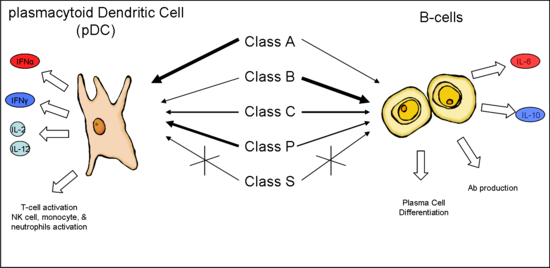
CpG oligodeoxynucleotides (or CpG ODN) are short single-stranded synthetic DNA molecules that contain a cytosine triphosphate deoxynucleotide ("C") followed by a guanine triphosphate deoxynucleotide ("G"). The "p" refers to the phosphodiester link between consecutive nucleotides, although some ODN have a modified phosphorothioate (PS) backbone instead. When these CpG motifs are unmethylated, they act as immunostimulants.[1] CpG motifs are considered pathogen-associated molecular patterns (PAMPs) due to their abundance in microbial genomes but their rarity in vertebrate genomes.[2] The CpG PAMP is recognized by the pattern recognition receptor (PRR) Toll-Like Receptor 9 (TLR9), which is constitutively expressed only in B cells and plasmacytoid dendritic cells (pDCs) in humans and other higher primates.[3]
- ^ Weiner GJ, Liu HM, Wooldridge JE, Dahle CE, Krieg AM (September 1997). "Immunostimulatory oligodeoxynucleotides containing the CpG motif are effective as immune adjuvants in tumor antigen immunization". Proceedings of the National Academy of Sciences of the United States of America. 94 (20): 10833–7. Bibcode:1997PNAS...9410833W. doi:10.1073/pnas.94.20.10833. PMC 23500. PMID 9380720.
- ^ Bauer S, Wagner H (2002). "Bacterial CpG-DNA licenses TLR9". Toll-Like Receptor Family Members and Their Ligands. Current Topics in Microbiology and Immunology. Vol. 270. pp. 145–54. doi:10.1007/978-3-642-59430-4_9. ISBN 978-3-642-63975-3. PMID 12467249.
- ^ Rothenfusser S, Tuma E, Endres S, Hartmann G (December 2002). "Plasmacytoid dendritic cells: the key to CpG". Human Immunology. 63 (12): 1111–9. doi:10.1016/S0198-8859(02)00749-8. PMID 12480254.